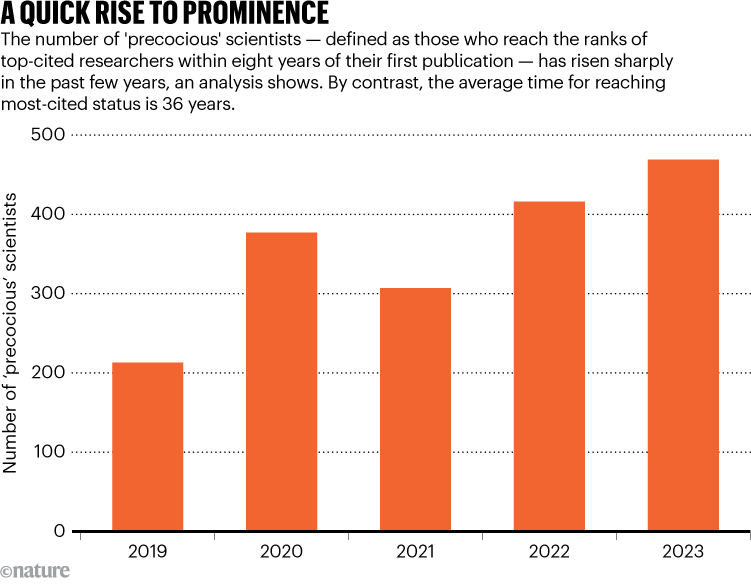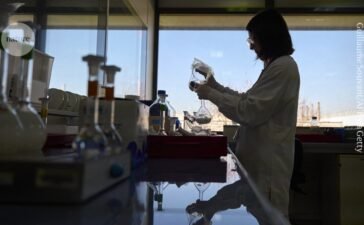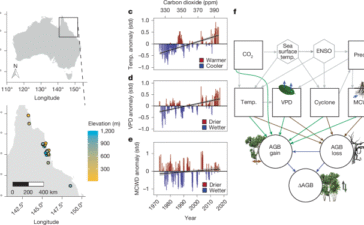
In 2023, more than 450 scientists who had begun publishing research only in the previous eight years were among the ranks of most-cited researchers. Credit: Getty
The number of ‘precocious’ scientists — those who become top-cited authors early in their careers — has surged in the past few years, according to an analysis1 of the publishing records of hundreds of thousands of scientists.
Many of these precocious authors publish what the analysis calls an ‘extreme’ number of papers — an average of more than one per week. The analysis also found that these authors often cite their own papers at a rate well above the average. Some level of such ‘self-citation’ is common in scientific papers, but the average rate is around 13%, whereas some of these authors’ rates were 25–50%.
The citation black market: schemes selling fake references alarm scientists
The analysis was posted on the bioRxiv preprint server on 15 October and has not yet been peer reviewed. However, another researcher who was not an author of the analysis says its methods seem sound.
Some of the precocious authors show no signs of questionable publishing habits and probably made it on to the list through talent and hard work, says John Ioannidis, the author of the preprint and a physician at Stanford University in California who specializes in meta-research, the study of how research is done.
But scientists say the trend raises questions about how so many authors have racked up such a large number of citations so quickly.
Zach Adelman, an entomologist at Texas A&M University in College Station, says that although there are probably true overachievers in the mix, “I don’t think that we’re all of a sudden mass-producing more geniuses now than we were five years ago.”
Early achievers
Ioannidis used data from the Scopus citation database to compile a list of top-cited researchers on the basis of a metric he calls a “composite citation indicator”, which takes into account the varying levels of contribution by a paper’s co-authors. The index combines data including the total number of citations a researcher’s work has accrued, the scientist’s placement on each paper’s author list and the individual’s h-index, a measurement of research output that includes citation count and number of publications.
Ioannidis used the composite index to identify top-cited scientists: those whose citation indices are in the top 2% for their field or in the top 100,000 across all fields. He defined “precocious” scientists as those who reached the top-cited list within eight years of their first publication, and “ultra-precocious” as those who did so within five years. By contrast, the average time from first publication to most-cited status was 36 years.

Source: Ref. 1
The analysis revealed a marked rise in the number of top-cited early-career researchers between 2019 and 2023, the period for which Ioannidis has complete data. During this time, the number of precocious authors increased from 213 to 469, and ultra-precocious authors increased from 28 to 59.
Digging deeper into the data, Ioannidis found that 31% of the ultra-precocious authors cited themselves more often than did 95% of the authors in their field, and that 20% fell off the top-cited list when self-citations were excluded. When Ioannidis included some 2024 data, he found that 17 of the authors who qualified as ultra-precocious had had at least one paper retracted.
There can be innocent explanations for such findings: authors can retract their own papers after catching honest mistakes, and scientists might cite themselves frequently if they are especially productive. But a large body of retractions or a high rate of self-citation could also be a sign of unusual publishing behaviours, Ioannidis says.
Domingo Docampo, a specialist in statistical signal processing at the University of Vigo in Spain who has used some of the same metrics to investigate citation fraud, says that the methods used in the study are sound. “The indicators are believable and can be useful for anyone doing evaluations of researchers,” he says.
Citation red flags
Ioannidis found that some researchers had not only cited themselves heavily but also accrued a relatively large number of citations in a relatively small number of papers. The findings suggest that scientists are engaging in attempts to improve their h-index, Ioannidis says. For instance, some of the precocious authors had published what he calls “sometimes nonsensical papers” that included dozens or even 100 citations to their own papers, he says.
You Might Also Like
US PhD admissions shrink as fears over Trump’s cuts take hold
Many academic departments at US universities are planning to cut the size of graduate-student cohorts.Credit: Sophie Park/Bloomberg/GettyPhoenix-Avery Sarían has been...
Is academic research becoming too competitive? Nature examines the data
Success rates for Europe’s leading research grants are declining — some to single percentage points — as a surge in...
Aboveground biomass in Australian tropical forests now a net carbon source
Pan, Y. et al. The enduring world forest carbon sink. Nature 631, 563–569 (2024).Article ADS CAS PubMed Google Scholar Cox,...
The world’s first plastics treaty is in crisis: can it be salvaged?
Global consumption of plastics is on the rise, but only a small percentage of plastic waste is recycled. Credit: Justin...











